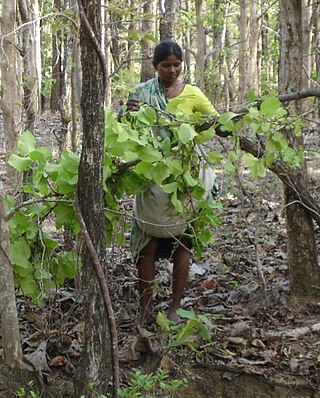Diospyros melanoxylon, the Coromandel ebony or East Indian ebony, is a species of flowering tree in the family Ebenaceae native to India and Sri Lanka; it has a hard, dry bark. Its common name derives from Coromandel, the coast of southeastern India. Locally it is known as temburini or by its Hindi name tendu. In Odisha, Jharkhand, and Assam, it is known as kendu. In Andhra Pradesh, and Telangana it is known as tuniki. [3] The leaves can be wrapped around tobacco to create the Indian beedi,[4] which has outsold conventional cigarettes in India.[5] The olive-green fruit of the tree is edible.[6]
| Coromandel ebony | |
|---|---|
 | |
| Bark of the Coromandel ebony | |
| Scientific classification | |
| Kingdom: | Plantae |
| Clade: | Tracheophytes |
| Clade: | Angiosperms |
| Clade: | Eudicots |
| Clade: | Asterids |
| Order: | Ericales |
| Family: | Ebenaceae |
| Genus: | Diospyros |
| Species: | D. melanoxylon |
| Binomial name | |
| Diospyros melanoxylon | |
| Synonyms[2] | |
| |
Pharmacology


The leaf of the tree contains valuable flavones.[7] The pentacyclic triterpenes found in the leaves possess antimicrobial properties,[8] while the bark shows antihyperglycemic activity.[9] The bark of four Diospyros species found in India has been determined to have significant antiplasmodial effects against Plasmodium falciparum, which causes malaria in humans.[10]
Method of collection
Tendu leaves are used as a wrapper for beedi. During the summer, fresh leaves are produced by the suckers that emerge from the soil. This is also enhanced by lighting a fire beneath the Tendu tree. The fresh leaves are hand-picked by the tribals and dried in the sun for 10 days. This practice is seen in Maharashtra, Madhya Pradesh, Odisha and Chhattisgarh states of India. The State Government gives the license for collection and processing of the tendu leaves through tender every year.[11]
Culture and mythology
Tendu, also known as Tiril, and Kendu has cultural and mythological reference as well. According to the Munda people, during the ancient Sengael Deaah (an event of raining fire) their predecessors took shelter in the tree hollow of the Tiril tree. Tiril(tendu) tree is considered not easily flammable. A tree hollow in the tiril tree is a usual sight as the tribes strike the trunk with big stones in order to make the ripened fruit fall. This repeated striking over time makes a hole in the tree.
Due to the non-flammable nature of the tree, after the plantation of paddy, the tribes plant a branch of it in the field in order to protect the crop from any events of Sengael Deaah in the future.[12]
Tendu tree is also used in making hockey sticks by the adivasis of Jharkhand and Odisha. A young and straight branch of the tree is heated in fire and slowly shaped into the curves of a hockey stick.
Many villages have been named after the location and presence of the tree in the neighbourhood. These include Tiril Posi, Tiril, Tiril Haatu, Kenduda('Tendu' is also known as Kendu in the South Chotanagpur region) in Jharkhand and the Kendhujhar district in Odisha
Varieties
There is one named variety of this species, Diospyros melanoxylon var. tupru.[13]
References
Wikiwand in your browser!
Seamless Wikipedia browsing. On steroids.
Every time you click a link to Wikipedia, Wiktionary or Wikiquote in your browser's search results, it will show the modern Wikiwand interface.
Wikiwand extension is a five stars, simple, with minimum permission required to keep your browsing private, safe and transparent.
